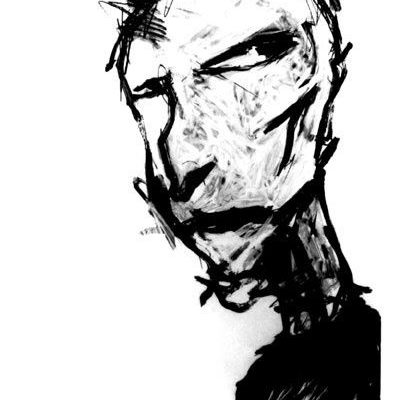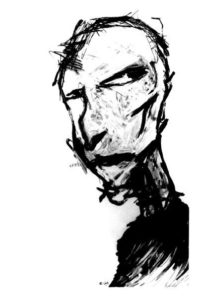
Bearing the nickname “The Screw”, which fits perfectly with his emaciated physique and his ability to pierce through situations and beings, Rafik Majzoub migrated from Amman to Beirut in search for more breathing freedom.

Rafik Majzoub n-and-b: Hom 2 acrylic and charcoal on paper 2001
Carrying everywhere a diary sketch book, he unceasingly consigns his impressions of moments, places and faces, striving to transcend individual physiognomies towards their archetypes: he does not draw this or that poet, but the Poet, this or that envious person, but the Envious, this or that cunning, but the Cunning. He does not just scribble single words without more ado. He reiterates them on whole pages: ennui, ennui, ennui, ennui, ennui, ad libitum, perplexity, perplexity, perplexity, perplexity, perplexity, ad infinitum. As if the incantation had in itself an emancipatory power, or if any word describing his state of mind could transform into a magical mantra capable of leading to the exit from some interior labyrinth.
His rage to take note of everything is a kind of permanent self-training. Is it because Rafik Majzoub is a self-taught draughtsman and painter? The angular lines in his drawings echo the sharpness of his own “screw” face: his characters are metamorphoses of himself, charged with his phobias, his rejections, his rebelliousness. His paintings, essentially based on a graphic approach, rendered him naturally thrifty with color, perhaps less out of a pursuit for sobriety than a paucity of means.
It was not long before Rafik Majzoub turned into the fetish painter of his generation: smothered by the established order and disorder, cynically exploited by a corporate and feudal Establishment with which it simply cannot identify itself, it recognizes in him something of itself and of its predicament. In the absence of vital perspectives, trustworthy ideologies and credible political programs after the devaluation of all values, it has no recourse other than to lose itself in the daze of alcohol, sex, drugs, music, endless entertainment and aimless wandering in cyberspace. Disempowered, the pathetic children of this lost generation indulge in wounded irony, bitter sarcasm, desperate derision, revulsion from the world and its pomp, from society and its perpetual shamming. First and foremost, perhaps, and just as much, from their own selves. How can they love themselves when they don’t believe in anything anymore?
Rafik Majzoub has in a way emerged as a herald from the midst of this war and post-war generation. The other angry painters had early on dropped out after having simply been co-opted and integrated into the system. Rafik Majzoub is the only one left to bring us the down and low. He does it first and foremost for himself.
The Enemy Inside
After a “black period”, here is his “polychrome period”. Entertain no illusions: deep at heart, Rafik’s colors are blacker than his previous black that tackled an enemy on the outside. Today, the enemy is on site: it is no other than himself.
The outside world is foreclosed. Snuggled in his room, Rafik is confined in a hermetic huis clos, to undergo self-examination, settle accounts with himself without concession, tenderness or false modesty. He is the subject-protagonist, the physical resemblance does not deceive, but we too are just as well the protagonists, we hypocritical viewers, his kin, his brothers.
The end balance does not seem positive: all self-esteem swept away, he throws himself in the john, folded on himself like a disjointed puppet, his feet hanging, his arms flailing, his head recoiled. There is no better icon of the devaluation of man assimilated to a lump of feces. Moreover, the water chain from the toilet dangles on the side: in an ultimate effort of self-denigration, the pathetic puppet could almost yank it to flush himself in the sewer. In its excess this image might seem caricatural, but it does not inspire laughter.
In his solitary drift, our hirsute hero strives ravenously to reflect on his situation, to ponder over his existence with a grim gaze and a scowling expression, buried in a chair or standing upright, not quite sure what to do with his hands. Get drunk and stagger against the bar? Sip a cup coffee? But he is only able to overturn the table, because nothing can remain stable in this disoriented world. Masturbate and hallucinate that he is being masturbated by another himself, as if self-gratification, the last resort of the forlorn, held a salvational virtue?
These endeavors only lead to more alarm, consternation, contrition, and regret. The adventure in self-sufficiency turns into near autism, the journeying within the room and the artist’s own self leads him to the end of the roll (the toilet paper roll just as well) and leaves him, more than ever, enervated and bewildered: there is no outcome from the solitary confrontation with oneself, except for melancholy or depression, for the lack of an instance of transcendence able to impart an upward pull or push, in whichever form. Hence the swallowing up in the immanent, with the assimilation of the self to excrement and sewage all at once.
This trying denunciation of the emptiness of existence and the absence of markers, references and points of anchor, reflects the interior bankruptcy of the individual trapped inside the pointless labyrinth that is no other than his own self, a self that cannot even hope to endow itself with those wings made from wax that would melt at the first vague impulses for an upward escape. The pathetic human puppet in the john is the Majzoubian version of the fall of Icarus, not because he took flight (at least Icarus had come near the sun, granted a little too near for his own good) but because he could not take flight: the dismembered limbs are the analogs of the broken wings of old.
The Illusion of Perfection
Rafik’s painting is totally contemporary, without accessory or artifice, solely focused on the protagonist in search for his self, outlined on colored but neutral backgrounds. Every line, every shade, every spill, every violence in the brushstrokes, every transparency, all combine to create the impression of a work in progress, making it open, unfinished, or rather unconcluded: an unfullfilment that echoes the essential unfullfilment of the human being , of being itself.
The illusion of a perfect world has dissipated a long time ago. Painting, which had fed this erroneous semblance far too much, no longer wishes to have anything to do with it, even in its methods. In this fractured, fragmented, imperfect world – in spite of globalization or because of it – the painter’s hand responds with nervousness, impatience, velocity, disregard of the exact and the calculated to the benefit of the expressive and the improvised. In a sense, a finished painting, without anything random, frenzied, unconcluded or unresolved is today, for many in Lebanon, a painting that is ethically and aesthetically suspect.
With his disheveled hair, triangular gait, bony figure, lanky limbs, pants in a ball, the painted representation of Rafik is just what it should be in this acrylic age: endowed with a formal consistency sufficient enough to lend credit to his virtual existence. Nevertheless, inhabited with an impressive presence, Rafk’s painting is decidedly powerful.
From now on, this young man, who has come to Beirut from elsewhere and who has begun to take his craft as a painter seriously, has to be contended with. In one swoop, he has barged into the playground of the seniors. Unexpectedly, Zorro has intruded upon us. And he has already thrown down his mask.